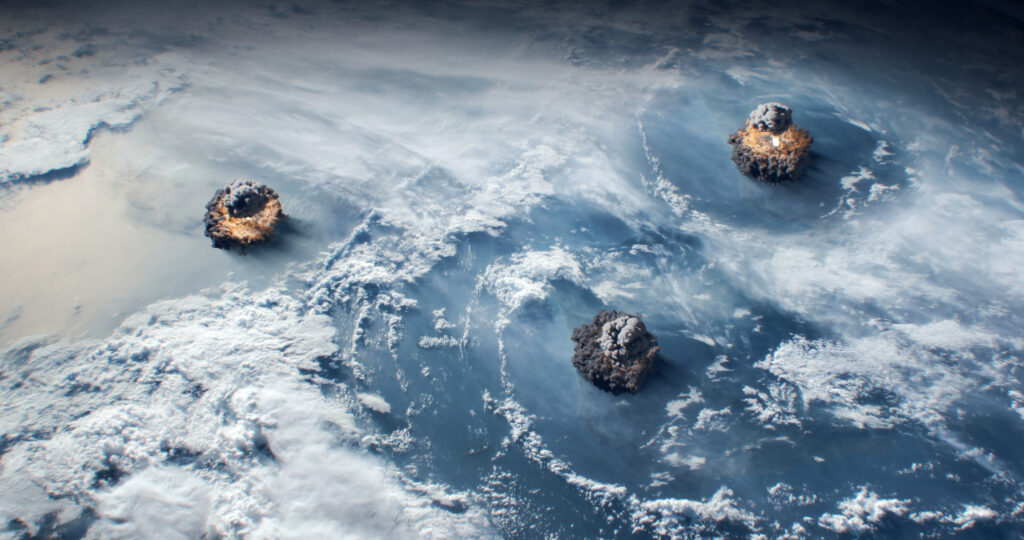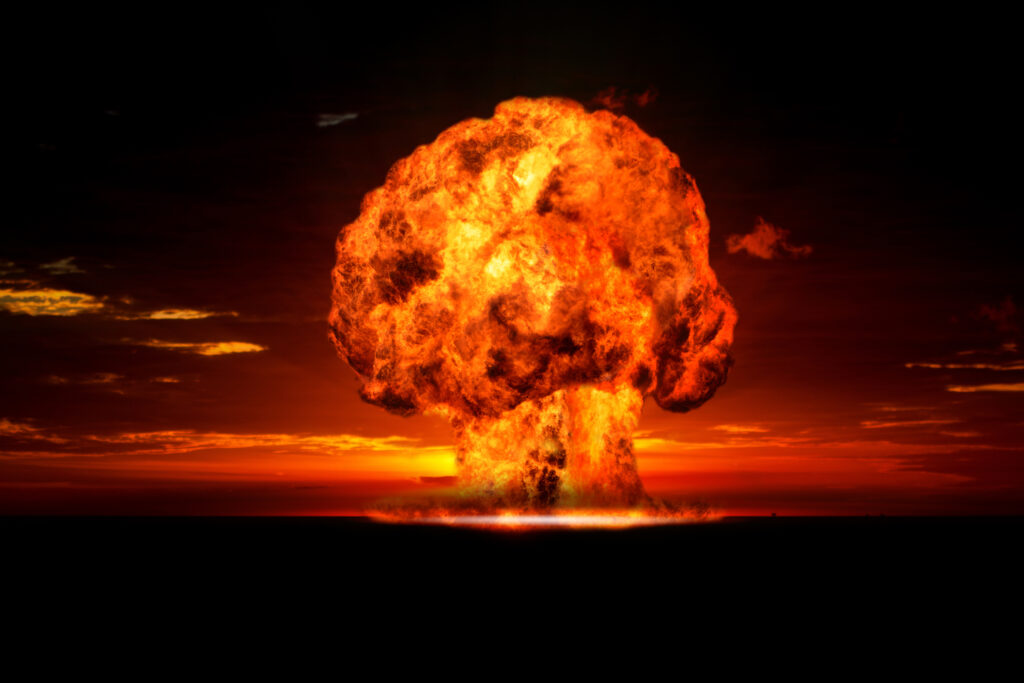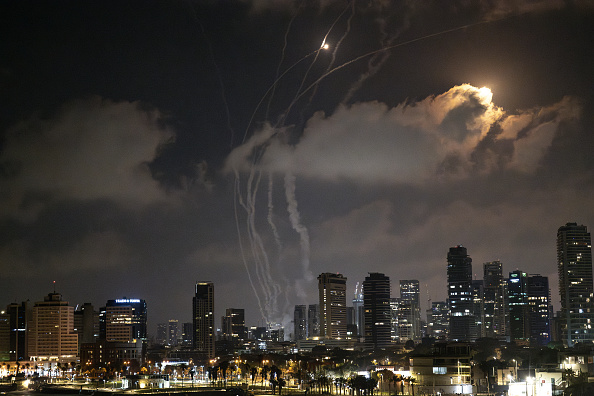The Hydra of ‘Hybrid War’

What should we call the ongoing confrontation between Russia and the United States? The lack of clarity about the precise nature of the conflict is rooted in a complicated history and ambiguous language. Yet this uncertainty also stems from a failure of imagination—and an unwillingness to come to terms with where this stand-off between the two countries with the world’s largest nuclear arsenals may be headed.
Ukraine is the geographic center of Russian-American hostilities. Yet Washington rejects the notion that it’s at war with Russia over Ukraine. Instead, President Joe Biden has characterized U.S. policy as a commitment “to standing with the people of Ukraine for as long as it takes.” The White House has not yet spelled out what that means, however, and American elites have for decades engaged in military conflict without formal declarations of war.
Meanwhile, Ukrainian authorities bristle at the idea that American and NATO backing for Kyiv remotely resembles anything like a “proxy war” against an invading Russian army. They argue that it is a war for Ukraine’s survival. Numerous experts in the West have assigned even more sweeping labels to the conflict, likening it to a war for the future of freedom and democracy across the globe.
Leaving aside whether Russia’s brutal invasion of Ukraine is more consequential for global democracy than, say, the conflict in Sudan or elsewhere, the terms circulating in media coverage and policy discussions remain worryingly vague.
In a multipolar nuclear age, what does it mean for involvement in a war to be “indirect”? When does a “proxy” war become something very different?
What has been missing from the debate in the U.S. and much of Europe is an appreciation of how the Russian position has evolved since Moscow’s invasion of Ukraine in February 2022. American and NATO leaders have largely failed to notice that a growing number of Russian voices have arrived at a disturbing conclusion: from their perspective, the U.S. and Russia are effectively at war.
As this framing of the conflict has become more widely accepted in Russia, an unprecedented—and very public—conversation has crystallized in recent weeks about the potential necessity of using nuclear weapons. Even before Yevgeny Prigozhin’s mutiny raised renewed questions about political succession in Moscow, the feverish spread of nuclear threat talk in Russian government and expert circles should have soared to the top of the list of policy-makers’ concerns in Washington, Brussels, Kyiv, Warsaw, Riga, Helsinki, and elsewhere. But the issue has not received the careful attention it deserves.
Escalation aimed at the U.S. and NATO—long dismissed by their officials and pundits—is already in motion. The public is long overdue for an honest debate about what’s at stake when one great power denies it’s at war—and the other is sabre rattling with nukes.
Who Decides When You’re at War?
Debates about Vladimir Putin’s motives for invading Ukraine are still hotly contested. What remains crystal clear, though, is that from day one of his misguided “special military operation,” Putin has explained it to the Russian public and the world as an act of self-defense: the aim, he told a TV audience on February 22, 2022, was to prevent Ukraine from becoming the next pawn in a decades-long American scheme to assert itself as the global hegemon and to destroy Russia once and for all.
‘For the U.S. and its allies, this so-called policy of deterring Russia has had clear geopolitical dividends. But for our country—it is in essence a question of life and death, a question of our historical future as a people. This is not exaggeration. This is exactly what it is. This is a genuine threat not only to our interests, but to the very existence of our state and our sovereignty. This is the very redline about which we spoke repeatedly. And they have crossed it.’
Sixteen months into the war, Putin claimed in a June 16, 2023 interview that it was in fact the Ukrainians who had initiated the conflict already in 2014 “with the support of their sponsors in the West.” Though not talked about in the West, he asserted, “I have to remind [everyone]: aviation, tanks, and artillery were used in the northwest against the Donbas. What is that, if not war? It is precisely war.”
Following Western neglect of the Minsk agreements (referring to international negotiations to resolve the conflict in Eastern Ukraine), he added, “we see that Western countries are exerting maximum effort to ensure that Russia, as they say, is defeated on the battle field and are doing everything in their power to deliver a strategic defeat as well.”
When asked whether he regards NATO as a “participant in the war,” Putin answered, “NATO is of course being drawn into the war.”
Fast forward to Putin’s TV address of June 24 in which he condemned Prigozhin’s “treason” and returned to the theme of Russia facing an existential threat from the West:
‘Today Russia is waging the most arduous struggle for its future and resisting the aggression of Neo-Nazis and their masters. We are the target of basically the entire military, economic, and information machine of the West. We are fighting for the lives and security of our people, for our sovereignty and independence. For the right to exist and remain as Russia—a state with a thousand-year history.’
In key respects, though, Russian characterizations of “war” have, as in the West, been put forward in somewhat hazy formulations. In May, the former president Dmitrii Medvedev charged that British involvement qualified, per the Hague and Geneva Conventions, as “de facto” war against Russia. Also in May, Foreign Minister Sergei Lavrov insisted that the “collective West” had declared a “hybrid war” against Russia.
Putin, too, has utilized this terminology, for instance when in September 2022 he marked the referenda supposedly offering popular support for Russian annexation of four Ukrainian regions, declaring, “I want to emphasize again, that it is avarice, the intention to maintain completely unlimited power, that are the real reasons behind the hybrid war that the collective West is waging against Russia.”
The Hydra of ‘Hybrid Warfare’
The two most alarming features of this language are that the notion of “hybrid war” sweepingly expands what counts as “war”—and that the term has been adopted by key players in Moscow and Washington as the magical key to understanding conflict in our era. Frank Hoffmann, a U.S. military expert, popularized the term in 2007 as a way to try to make sense of the whirlwind of chaos unleashed by American interventions in Afghanistan and Iraq. In turn, Ukrainian observers saw “hybrid war” at work in the Russian annexation of Crimea in 2014 and the simultaneous sponsorship of Russian-backed dissident groups in Eastern Ukraine. However, by 2015, leading Russian military figures had begun to challenge American troop deployments to the Baltic states, accusing the U.S. of waging a hybrid war against Russia.
Russian military experts have taken note of the rise in American military circles of “hybrid warfare” as short-hand for describing the simultaneous use of multiple kinds of traditional and non-traditional force. A 2017 article in the official Russian journal Military Thought defined it as
‘a complex of measures of interstate warfare to advance national interests. Its essence and contents consists of conducting hostilities both by means of regular military units and the deployment of non-state actors (ideologically motivated fighters, local forces, private formations, international mercenaries, and foreign ‘specialists,’ with whom cooperation is denied) for the purposes of a single plan and project for the achievement of a single goal. In the opinion of NATO generals, the technology of hybrid wars applied on their side guarantees their unquestioned dominance, which is difficult to neutralize.’1
A 2019 Military Thought article went further in warning that Western conceptions of warfare had expanded in disconcerting ways. This now entailed “not only armed conflict on the traditional battle field, but also antagonism in the diplomatic sphere, domestic political and civil conflicts, and behavioral, informational, financial, economic, and technological confrontation. For the representatives of Western civilization, all of this has now become synonymous with the word ‘war.’ ”
‘On land and sea, in the air, space, and cyber-realm, the Pentagon is determined to wage hybrid, asymmetric, and counterinsurgency wars, which in the media, also a resource and means of military activities, will be called “conflict,” “antagonism,” or “confrontation” [emphasis in the original]. In reality, humanity is entering a new era of “world wars” and “shadow wars.”’2
Warnings about American and NATO hybrid warfare aimed at Russia quickly entered the wider Russian media landscape, complete with the claim that use of nuclear weapons—and support for subversive “color revolutions” in neighboring states—were key features of this new strategy.

Going Nuclear?
For nearly two decades, the Kremlin has objected to the construction of nuclear defense infrastructure including radar and missile defense systems in Poland, the Czech Republic, and elsewhere as measures that undermine nuclear parity. But the nuclear issue has taken on new urgency in Moscow.
Confronted with what Russian officials and experts are calling hybrid warfare—and a stalled offensive in Ukraine, Russian officials have made a notable shift in recent months to underscore Russia’s nuclear weapons capacity and to make clear that they see this war as a confrontation of nuclear powers.
In February, Putin pointedly suspended Russian participation in the New START treaty, the centerpiece of U.S.-Russian nuclear arms control, which limits warheads and the infrastructure that deploys them. In the weeks that followed, Foreign Minister Sergei Lavrov charged, “[I]n fact, and in essence de jure, NATO countries are directly participating in the conflict on the side of Kyiv. This reckless course substantially raises the threat of military confrontation between nuclear powers.”
Putin announced in March that he would answer British plans to provide Ukrainian forces with depleted uranium shells by deploying tactical nuclear weapons to Belarus. Commenting on the Russian nukes on Belarusian territory, President Alexander Lukashenko boasted that “the bombs are three times more powerful than at Hiroshima and Nagasaki. They could kill a million people at once.” Anticipating completion of the delivery in July, Russia will retain control of the weapons, which gives the Kremlin additional flexibility in potentially targeting Poland and the Baltic states in addition to Ukraine.
“It’s clear,” added Medvedev in May, “that a full-scale hybrid war is being waged against our country. They are pushing the matter to a Third World War in which, as we know, there can be no victors.” “The likelihood of a nuclear apocalypse,” the former president continued, “depends directly on the degree of weapons supplied to Kyiv.”
Medvedev offered this warning in connection with plans for NATO countries to send F-16 fighter jets to Ukraine. The Russian government responded by giving the issue a nuclear spin, protesting that the jets were unacceptable precisely because they are “capable of carrying nuclear weapons.” Lavrov ominously warned that Russian defense systems could not distinguish between F-16s carrying nukes and those without them.
Meanwhile, influential Russian foreign policy experts have argued that Russia should be more aggressive in capitalizing on its nuclear arsenal. On June 13, Sergei Karaganov, a security scholar with connections to the Kremlin, argued that “[F]ear of nuclear escalation has to be restored. Otherwise humanity is doomed.” To put the West in its place once and for all, and for the sake of the entire planet, Karaganov proposed that Russia consider using a tactical nuke in Ukraine.
‘Today what is being decided on the fields of Ukraine is not just what Russia will become but the future world order. And whether the world to which we are accustomed will survive at all, or only radioactive ruins and the toxic remains of humanity will remain. Having broken the West’s will toward aggression, we’ll not only be saving ourselves, finally freeing the world of five decades of the Western yoke, but we’ll also save all of humanity. Pushing the West toward catharsis and the refusal of hegemony by its elites, we’ll force it to back down before there’s a global catastrophe. Humanity will enjoy a new chance for development. … The enemy should know: we’re ready to deliver a pre-emptive strike in retaliation for all of its current and past aggression in order to prevent a drift into global thermal nuclear war.’
Given Karaganov’s eminence—and the messianic tone of the article, Karaganov’s call for lowering the threshold for first-use of a nuclear weapon attracted considerable attention in Russia. Putin was drawn into the conversation in his June 16 interview, noting that there was no need to consider use of a tactical nuclear weapon at this moment because, he insisted, the Ukrainian counteroffensive was failing. Putin explained that it was “theoretically possible” to use such a weapon, but that “[F]or Russia, it is possible [only] on the condition that there emerges a threat to our territorial integrity, independence and sovereignty, or the existence of the Russian state. Nuclear weaponry exists to safeguard our security in the very widest sense of the word and the existence of the Russian state.”
Putin’s coy language took a sharper turn when he added that the tactical nuclear weapons he was transferring to Belarus were “precisely an element of deterrence, so that whoever thinks of inflicting a strategic defeat upon us won’t forget about this situation.” However, the Russian president immediately pivoted to painting the U.S. as the eternal aggressor and placing Russia on a higher moral plane: “I remind you that the only country in the world that has employed a nuclear weapon in relation to a non-nuclear state—this country is the United States of America, which twice struck the Japanese cities of Hiroshima and Nagasaki. They thought they were doing the right thing. The United States established this precedent.”
Red Lines and Mushroom Clouds
“We don’t want the smoking gun to be a mushroom cloud,” Condoleezza Rice warned the world in 2002 in making the case for a pre-emptive war to topple Saddam Hussain in Iraq. The Bush White House wanted the public to be terrified of a nuclear-armed Iraq—or Iran. But the Biden administration continues to wave off worries about nuclear escalation when it comes to Ukraine and Russia.
Secretary of State Anthony Blinken has spoken of the goal of avoiding “a lot of conflagration” in Ukraine but has also claimed on multiple occasions that Russian warnings of escalation are a bluff. On the one-year anniversary of the war, he asserted
‘If Putin did something that created escalation and that brought NATO in, that’s really the last thing he wants. Because as it is, we all know he is struggling mightily in Ukraine right now. He’s got about 80-plus percent of his land forces committed in Ukraine. And in fact, in an almost perverse logic, because he is falsely concerned that NATO poses a threat to Russia, he has to keep some things in reserve lest there be a conflict that he creates with NATO. So I think that’s been the biggest deterrent against escalation.’
However, Blinken’s understanding of Russian strategic thought does not take long-standing and extensively documented Russian views into account. Crucially, his thinking is rooted in the refusal to see NATO as a threat to how Russians understand their security, despite more than three decades of Russian pronouncements explaining the Kremlin’s position.
Blinken’s unwillingness to see NATO as others, including but not only how Russia sees it, is dangerous. And yet the secretary has played a central role in pushing policy decisions that have reinforced Russian perceptions that the U.S. is a war-time enemy out to destroy their country. According to Lara Seligman in Politico, he was pivotal in pushing Biden toward the provision of F-16s in May: “Blinken had observed over the past year that Russia rarely escalates beyond rhetoric, even as the West has introduced more military offerings into Ukraine.”
The idea has become part of the Washington consensus on Ukraine and Russia. A Washington Post article on Biden’s path toward the approval of F-16s for Ukraine echoed American officials’ repeated assertion that Russian objections were insincere and not to be taken seriously in Washington’s calculations: “As the war has dragged on, the warnings from Putin and his subordinates have only become more bombastic, threatening a nuclear holocaust if Russia faced setbacks on the battlefield.”
The apparent fizzling of Prigozhin’s mutiny and Putin’s seeming compromise with him has further emboldened pundits who have dismissed the Russian president’s warnings as idle talk.

Such pollyannish reading of the moment does not change the reality that what Washington sees as a reasonable response to Russian “bombast,” Moscow sees as total disregard for Russian interests. “In the American book of rules on which the world is based, our ‘red lines’ don’t exist at all,” observed the eminent Russian foreign policy experts Dmitrii Trenin and Fedor Lukyanov in a recent interview addressing the nuclear issue. Trenin and Lukyanov noted that they see American security strategy operating on the false assumption that Russia won’t use nuclear weapons. One of them also stressed the necessity of taking Putin at his word:
‘And here, in my view, lies a potentially fatal miscalculation for all of humanity, because Putin’s phrase of 2018 has stuck with me, namely that ‘we have no need for a world without Russia.’ I recall it constantly. But I don’t think that many people have taken it seriously in the United States, for example.’
In this view, the U.S. has become too detached from the threat of a nuclear war whose epicenter would be in Europe. To restore deterrence, the Americans have to relearn fear.
Trenin, Lukyanov, and other Russian observers have speculated about how the Kremlin might respond—given its nuclear doctrine focusing on protection of the “territorial integrity” and “the existence of the Russian state”—to Ukrainian attempts to reclaim territories annexed by Russia, including Crimea, Donetsk, Luhansk, Kherson, and Zaporozhzhia.
What are the political and geographic limits of “the Russian state”? Who would pay in the event of Putin’s dreaded “strategic defeat”? Who decides when a threat is “existential”?
What Counts as War in 2023?
In light of the stakes, it bears taking stock of what Washington views as “standing with the people of Ukraine,” and Moscow interprets as “hybrid war.” Since the Russian invasion, the Americans have sent at least $46 billion dollars to Kyiv in military aid, including Stinger and Javelin missiles, jets, tanks, armored vehicles, helicopters, boats, drones, artillery, air defense systems, mortars, rockets, small arms, ammunition, body armor, night vision equipment, and more.
In addition to freezing Russian assets and imposing sanctions on Russian financial institutions and government officials, the U.S. government has raised tariffs on Russian products (including minerals and metals) and limited exports to Russia. In February the White House summed up these efforts, declaring, “[W]e have led unprecedented efforts to isolate and impose costs on Russia—including the largest coordinated sanctions and export control actions taken against a major economy.”
Building on more than two decades of joint training exercises, Washington has shared strategic intelligence and guidance. American officials have not been shy about revealing that their actions have led to the deaths of Russians—including generals. On a recent visit to Kyiv, Sen. Lindsey Graham spoke for many in Washington when he proclaimed that American aid that led to Russians dying was “the best money we’ve ever spent.”
Yet this is not the whole story. In April a leak of classified Pentagon documents revealed that special forces from the U.S. and other NATO countries are on the ground in Ukraine, though their activities remain shrouded in secrecy. And hundreds, if not thousands, of Americans, have traveled to Ukraine to fight against the Russians. Nearly all have been combat veterans with tours in Iraq or Afghanistan under their belts.
In recent years, moreover, American commandos have run “surrogate programs” in Ukraine. The Pentagon announced their suspension after the Russian invasion of February 2022. However, proposals to revive these programs, modeled on the counterterrorism operations of the last two decades, are now at the center of debates about expanding the American footprint on the ground in Eastern Europe. For their part, Russian media have claimed that Russian soldiers are fighting American and European mercenaries as well as NATO forces.
Meanwhile, the Biden administration has shifted to a more aggressive posture in arming Ukraine: at the G-7 meeting in May in Hiroshima, the president approved the transfer of F-16s to Kyiv after months of criticism from hawks who argued that the White House was being too cautious.
In June, American officials announced yet another policy shift: following internal debates about sharing weaponry that has wreaked havoc on public health in Iraq, the Biden administration had decided to send uranium-depleted rounds to be used with Abrams tanks.
It is difficult to predict how the Kremlin will answer growing American and NATO involvement in Ukraine, especially after the chaotic Prigozhin affair. Assassinations of Russians on pre-2014 Russian territory and mysterious bombings and drone strikes on Russian infrastructure, presumably carried out by Ukrainians, but denied by officials in Kyiv, have added yet another dimension of complexity. Lines of separation have been blurred further by other cross-border actions, most notably when a group of Russian far-right militants fighting on the side of Ukraine drove American-supplied Humvees and Maxxpro armored combat vehicles across the border into Russian territory in an incursion that targeted a town in Belgorod.
However, some of these recent developments can be understood by looking more closely at historical precedents: Moscow’s resort to calling numerous Ukrainian actions “terrorism” should be a red flag. Whether one accepts the Russian view that assassinations and bombings of civilian infrastructure constitute “terrorism” when carried out by Ukrainians, this language opens the door for an even wider war.
Counter-terrorism has been a through line of Russian geopolitics for over two decades. Similar accusations preceded Russian campaigns in the 1990s and early 2000s in Chechnya. Russian intervention in Syria is another illustration of what “fighting terror” has looked like.
It is important to understand that in his February 22 speech announcing the “special military operation,” Putin reminded his audience that “between 2000 and 2005 we delivered a military rebuff to terrorists in the Caucasus, defended the integrity of our state, and saved Russia.” In the next line, Putin turned to Crimea: “In 2014 we supported the people of Crimea and Sevastopol.” And then he seamlessly integrated Syria: “In 2015 we used the Armed Forces to create a firm barrier against the infiltration into Russia of terrorists from Syria. We had no other means to protect ourselves.”
Russian counter-terrorism has its own distinctive history, but since 2001 it forms part of a global trajectory, one led by the United States, which has offered justification for all kinds of state violence against militants and civilians alike. Very few states have in recent decades not taken advantage of the rhetorical force of this term to raise the stakes in conflicts with their opponents, real and imagined.
Beyond the immediate Ukrainian theater, the invocation of terrorism potentially places the U.S. and NATO countries in the Kremlin’s sites. The mysterious destruction of the Nord Stream pipelines in September 2022 is especially worrisome, because Russian authorities have declared it an act of “international terrorism.”
Whatever the actual American, Ukrainian, or NATO role in blowing up the pipelines, Putin’s circle is certain the perpetrators lie in “the West.” It remains unclear how Russia will respond, though Medvedev has darkly warned, “[I]f we proceed from the proven complicity of Western countries in blowing up the Nord Streams, then we have no constraints—even even moral—left to prevent us from destroying the ocean floor cable communications of our enemies.”
Medvedev’s threats about infrastructure highlight another direction war with Russia—unacknowledged by Blinken’s assurance that Russian infantry were bogged down in Ukraine—might take. Cyberwarfare and other attacks on critical infrastructure are only one possibility. Another is that something accidental, say, the collision of a plane, warship, or submarine, ignites a spiral of anxious speculation about the intentions of “the enemy.” As NATO and Russian aviation have concentrated over the Black and Baltic Seas—as well as over Syria—in greater numbers in dueling demonstrations since at least 2014, there have been dozens of near collisions and at least one actual crash with a drone.
The Cuban Missile Crisis played out over two weeks in 1962. The longer this war continues, the more likely it is that authorities in charge of the vast nuclear arsenals of both states will confront similar dilemmas.
The American public, in particular, is long overdue in recognizing that the Russian government views this conflict as a war with the U.S. and NATO. Of course there are no Russian missiles destroying hospitals and schools in the American Midwest. No mass graves in California, or civilians sheltering in the NY metro. It is the civilian population in Ukraine that has borne the brunt of Russian aggression: as of May 7, 2023, the United Nations has counted “23,606 civilian casualties in the country: 8,791 killed and 14,815 injured.”
These stark figures do not come close to doing justice to the suffering of millions of displaced and terrorized civilians in Ukraine. In Vladimir Putin’s war of choice, his forces have occupied and annexed Ukrainian territory. They have forcibly displaced and removed people—including children separated from their families—to Russian territory. Russian commanders have targeted civilians from the air and from long-range with drones, bombs, and missiles. And Russian forces have gone door to door in a number of locales murdering people at close range and carting off their refrigerators, shoes, telephones, and other personal items afterwards. Cruelty and absurdity abound.
But these facts do not clarify the precise nature of the Russian-American conflict. More than anything, publics in the U.S. and Europe need to make an honest assessment of the risks and rewards of current policies.
This is particularly urgent in light of the fact that the detonation of a single device or of multiple explosions aimed at Ukrainian military or civilian targets cannot be ruled out. Fantastically rosy portrayals of such a move have become more commonplace in recent months across the Russian mediascape. The prospect of “nuking” Ukraine would have been dismissed as grotesque science fiction at the birth of the century. Today such talk has been normalized.
Even if important commentators such as Sergei Karaganov are exaggerating their case for using a tactical nuclear weapon in Ukraine or Poland hoping it will intimidate Western officials, there is still a risk, as the Russian journalist Andrei Perstev has pointed out, that Russian intelligence will be swayed by this rhetoric and pass on the same delusional impressions to Putin as they did in the run-up to the Ukraine war when “the heads of the FSB convinced Putin that the Ukrainians would greet Russian soldiers with flowers.”
At the same time, most American politicians and media are in denial, still enthralled by the idea of delivering a crushing blow that will not only expel the Russians from Ukraine but also remake Russia itself.
Deciding when and how two countries go to war is rarely a mutually agreed upon affair. Washington doesn’t get to control how other states interpret war, especially when one side perceives that amorphous ideals such as “sovereignty” and “independence” are under threat. More than sixteen months into this war, the prospect of a military solution has faded. Given the growing risk of a catastrophic nuclear war, it is wholly irresponsible for all parties not to pursue a ceasefire and a diplomatic solution to the conflict.
Robert D. Crews is Professor of History at Stanford University.3
footnotes
- 1 [1] С. Г. ЧЕКИНОВ, С. А. БОГДАНОВ, “Эволюция сущности и содержания понятия “война” в XXI столетии,” Военная мысль, No. 1 (January 31, 2017): 30-43.
- 2 [2] А. С. БРЫЧКОВ, В. Л. ДОРОХОВ, Г. А. НИКОНОРОВ, “О гибридном характере войн и вооруженных конфликтов будущего,” Военная мысль, No. 2 (February 28, 2019): 15-28.
- 3 The author wishes to thank JP Daughton for his valuable insights and encouragement.



